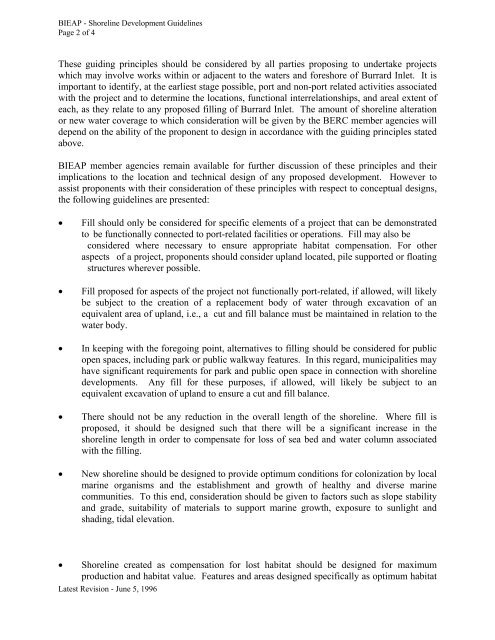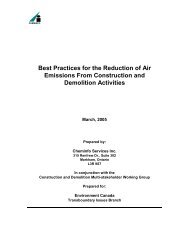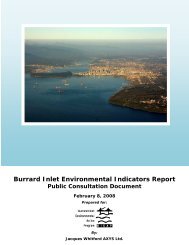burrard inlet environmental action program - the BIEAP and FREMP ...
burrard inlet environmental action program - the BIEAP and FREMP ...
burrard inlet environmental action program - the BIEAP and FREMP ...
Create successful ePaper yourself
Turn your PDF publications into a flip-book with our unique Google optimized e-Paper software.
<strong>BIEAP</strong> - Shoreline Development Guidelines<br />
Page 2 of 4<br />
These guiding principles should be considered by all parties proposing to undertake projects<br />
which may involve works within or adjacent to <strong>the</strong> waters <strong>and</strong> foreshore of Burrard Inlet. It is<br />
important to identify, at <strong>the</strong> earliest stage possible, port <strong>and</strong> non-port related activities associated<br />
with <strong>the</strong> project <strong>and</strong> to determine <strong>the</strong> locations, functional interrelationships, <strong>and</strong> areal extent of<br />
each, as <strong>the</strong>y relate to any proposed filling of Burrard Inlet. The amount of shoreline alteration<br />
or new water coverage to which consideration will be given by <strong>the</strong> BERC member agencies will<br />
depend on <strong>the</strong> ability of <strong>the</strong> proponent to design in accordance with <strong>the</strong> guiding principles stated<br />
above.<br />
<strong>BIEAP</strong> member agencies remain available for fur<strong>the</strong>r discussion of <strong>the</strong>se principles <strong>and</strong> <strong>the</strong>ir<br />
implications to <strong>the</strong> location <strong>and</strong> technical design of any proposed development. However to<br />
assist proponents with <strong>the</strong>ir consideration of <strong>the</strong>se principles with respect to conceptual designs,<br />
<strong>the</strong> following guidelines are presented:<br />
• Fill should only be considered for specific elements of a project that can be demonstrated<br />
to be functionally connected to port-related facilities or operations. Fill may also be<br />
considered where necessary to ensure appropriate habitat compensation. For o<strong>the</strong>r<br />
aspects of a project, proponents should consider upl<strong>and</strong> located, pile supported or floating<br />
structures wherever possible.<br />
• Fill proposed for aspects of <strong>the</strong> project not functionally port-related, if allowed, will likely<br />
be subject to <strong>the</strong> creation of a replacement body of water through excavation of an<br />
equivalent area of upl<strong>and</strong>, i.e., a cut <strong>and</strong> fill balance must be maintained in relation to <strong>the</strong><br />
water body.<br />
• In keeping with <strong>the</strong> foregoing point, alternatives to filling should be considered for public<br />
open spaces, including park or public walkway features. In this regard, municipalities may<br />
have significant requirements for park <strong>and</strong> public open space in connection with shoreline<br />
developments. Any fill for <strong>the</strong>se purposes, if allowed, will likely be subject to an<br />
equivalent excavation of upl<strong>and</strong> to ensure a cut <strong>and</strong> fill balance.<br />
• There should not be any reduction in <strong>the</strong> overall length of <strong>the</strong> shoreline. Where fill is<br />
proposed, it should be designed such that <strong>the</strong>re will be a significant increase in <strong>the</strong><br />
shoreline length in order to compensate for loss of sea bed <strong>and</strong> water column associated<br />
with <strong>the</strong> filling.<br />
• New shoreline should be designed to provide optimum conditions for colonization by local<br />
marine organisms <strong>and</strong> <strong>the</strong> establishment <strong>and</strong> growth of healthy <strong>and</strong> diverse marine<br />
communities. To this end, consideration should be given to factors such as slope stability<br />
<strong>and</strong> grade, suitability of materials to support marine growth, exposure to sunlight <strong>and</strong><br />
shading, tidal elevation.<br />
• Shoreline created as compensation for lost habitat should be designed for maximum<br />
production <strong>and</strong> habitat value. Features <strong>and</strong> areas designed specifically as optimum habitat<br />
Latest Revision - June 5, 1996
















